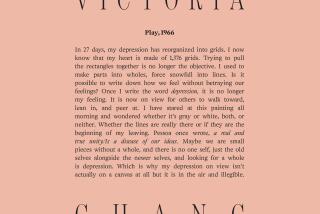The Poetry of Engagement
- Share via
Very late in his life, W.B. Yeats imagined himself in the Municipal Gallery of Dublin among paintings honoring the heroes of recent Irish history. “Around me the images of thirty years,” the poet writes in “The Municipal Gallery Revisited,” and after lingering among the portraits and the memories they evoke, he concludes, “Think where man’s glory most begins and ends/And say my glory was I had such friends.”
In a discussion of these lines in his 1995 Nobel lecture, Seamus Heaney contends that, despite being expansive and thrilling, “they are an instance of poetry flourishing itself rather than proving itself,” and of a poet who, captivated by the cut of his singing robes, ignores the circumstances that pricked him into song. In “Finders Keepers,” Heaney has gathered some of the best prose he has written during the last 30 years, and the pieces are vivacious portraits of poets who have mostly avoided Yeats’ indulgence.
Heaney’s central preoccupation is with the truth-telling capacity of poetry, or a poet’s ability to grapple with social reality without feeling vindictive or overly triumphant about his or her art. Although catastrophes such as the Holocaust, Heaney writes, have led people to wonder “if it is a delusion and a danger to expect poetry and music to do too much, it is a diminishment of them and a derogation to ignore what they can do.”
In the work of the poets he highly prizes--Zbigniew Herbert, W.H. Auden, Paul Muldoon, Czeslaw Milosz and even Yeats, in his unhaughty moments--Heaney detects a fluent, unresolved dialectic between lyric as pure lyric and lyric as moral conscience, between a language of expressionist exuberance and one of reasonable engagement.
What’s reasonable? As Heaney explains in “The Redress of Poetry,” poetry “does not intervene in the actual, but by offering consciousness a chance to recognize its predicaments, foreknow its capacities, and rehearse its comebacks in all kinds of venturesome ways, it does constitute a beneficent event.”
Heaney also devotes a corner of his gallery to untrammeled romantics such as John Clare and Osip Mandelstam, whose lyrical raids on the word-horde were acts of defiance against a forced social or political role. Verbs that appear frequently in these pages are “outstrip” and “outface,” and whether Heaney uses them to describe Irish poets of his own generation or Mandelstam’s impudent notes on Dante’s “Inferno” (which he wrote in the early 1930s before being packed off to the gulag for attacking Stalin in a poem), they refer to the complex act of a poet telling hard social truths without allowing them to harden his or her mind or art.
An Irish Catholic raised in Northern Ireland and living in Ulster when the Troubles erupted, Heaney is equally preoccupied with the intricacies of culture. He writes often about the indigenous but stresses that it rarely springs from bucolic turf. In “Mossbawm,” he recalls bathing in a moss hole as a child, “treading the liver-thick mud, unsettling a smoky muck off the bottom and coming out smeared and weedy and darkened.” The episode was not a baptism into territorial piety, however. In “Feeling Into Words,” Heaney chronicles how he came to believe in the confluence between poetic memory and the Irish bog- land, which archeological excavations in the late 1960s had revealed to be the preserve of ancient treasures and horrors.
Among the artifacts extracted from the murky waste were not only glistening slabs of white butter and the skeleton of a great Irish elk but also the remains of several Europeans ritually slaughtered during the Iron Age, whom Heaney views as the ancestors of civilians murdered during the Troubles. What’s salubrious about “Finders Keepers” is how Heaney manages to fathom such cultural fissions and fusions without resorting to the cant of postmodernism.
In Heaney’s lexicon, a poem is a piece of art, not a textual operation, and culture, no matter how murderous or divisive its history, can still bear value.
There are a few lulls in “Finders Keepers,” and they occur when Heaney travels beyond Europe’s western border. There are essays on Robert Lowell, Elizabeth Bishop and Sylvia Plath, whom Heaney likes mostly because they have achieved a particular style. The essays are as stylish and intelligent as any in the book, but they don’t deliver provocative insights about the poets. They are best read as barometers of Heaney’s formal preoccupations.
In fact, considering Heaney’s fascination with the subcultural life of indigenous speech and how it might irrigate national identity, one wonders what Heaney would say about the lyrics of W.C. Williams, Allen Ginsberg or Susan Howe, all of whom satisfy Heaney’s requirement that poetry “be antic, mettlesome, contrary, [retaining] the right to impudence.” Still, what one admires in much of “Finders Keepers” is the same tenacious curiosity that Heaney admires in the poetry of Herbert: the desire “to discover whether the inner citadel of a human being is a selfish bolt-hole or an attentive listening-post.”
More to Read
Sign up for our Book Club newsletter
Get the latest news, events and more from the Los Angeles Times Book Club, and help us get L.A. reading and talking.
You may occasionally receive promotional content from the Los Angeles Times.







